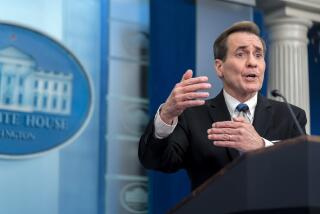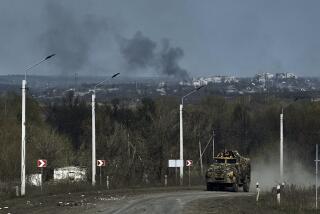U.S. Study Sees Easing of Soviet Military Threat
WASHINGTON — A still-classified review of U.S. defense strategy ordered by President Bush when he took office has concluded that the Soviet military threat to the United States is likely to be reduced significantly over the next decade if Moscow’s present policies endure, Administration officials have disclosed.
If so, the United States will have to reconsider the premises underlying its 40-year-old policy of containment--the strategy, dating back to the Administration of President Harry S. Truman, of trying to counter Soviet military power and influence around the world. Changes in the nature of the Soviet threat, for example, could raise questions about whether massive U.S. forces are still needed in Europe.
Until Soviet nuclear and conventional forces are reduced, however, the United States must maintain its guard, even as it seeks opportunities to further reduce tensions and to improve relations with the Kremlin under its reform-minded president, Mikhail S. Gorbachev, the review concluded.
Gorbachev’s activist foreign policy maneuvers will also pose a challenge to American strategists, perhaps as much as the actual changes in Soviet military power, the review found. The United States must be able to respond fairly quickly to the political impact in Western Europe--in particular, to Gorbachev’s many overtures.
This analysis of the Soviet threat, not significantly different from conventional wisdom among specialists outside the government, reflects the relatively conservative approach toward the Kremlin preferred by the Bush Administration.
Some top Bush Administration officials believe that President Ronald Reagan’s Administration became overly sanguine about Gorbachev. Others fear that the Republican right wing will attack Bush if he adopts Reagan’s optimism and openly embraces the Soviet president.
The defense study is part of an overall review of national security and foreign policy designed to guide the Bush Administration in making major policy decisions--from choosing a new land-based intercontinental ballistic missile to responding to the Soviet withdrawal from Afghanistan.
Controversy and Criticism
Although most new Presidents order similar policy reviews, the process has become a subject of controversy and criticism for the Bush Administration because it has dragged on longer than expected in view of the “friendly takeover” from the Reagan Administration.
That, in turn, has contributed to complaints that Bush has gotten his presidency off to a slow start and allowed the initiative to drift outside the White House. Bush has repeatedly fended off questions about future policy by saying that he will not be rushed into making decisions prematurely and that he must await completion of the review process.
Under this pressure, the White House is expressing dissatisfaction with both the pace and quality of the many reviews it has commissioned, and particularly with the defense review undertaken by the Pentagon.
Tardiness Cited
But bureaucrats, reacting to the criticism, note that the Bush Administration has been extremely tardy in ordering the reviews and in appointing new officials to conduct them.
“The TOR’s (terms of reference) for the studies, which could have been written the day after inauguration, didn’t reach us until last month,” complained one senior career official last week.
A successor to Rozanne L. Ridgway, the top State Department official responsible for European, including Soviet, affairs, has yet to be named, while key jobs in other agencies, including on the staff of the National Security Council, have only recently been filled.
A final criticism is that the White House orders did not have a theme or concept around which to build the review. For example, Brent Scowcroft, Bush’s national security adviser, has long espoused the goal of stability in arms control, rather than reductions in arms per se, since some reductions can be destabilizing. Bush apparently agrees with this thrust, but the terms of reference did not reflect it, the senior career official complained.
“The studies are conservative and don’t deviate drastically from current policy,” a senior White House official admitted. But they have value, he said, as “a benchmark, an intelligent notion of where we are and what are the extra-prudent ways to proceed. On them will be built innovation, new departures, as the President’s initiatives.”
More Than 30 Ordered
More than 30 studies, called Presidential Strategic Reviews, have been ordered by the White House.
So far only one study, dealing with Central America, has been completed. The White House announced several weeks ago that the U.S. focus will shift more to diplomatic pressure to achieve democracy in Nicaragua, with the rearming of the Contras an option if the Sandinistas fail to persuade the world that they are moving in that direction.
Drafts of three other studies were examined last week by the National Security Council, with Bush present. The reviews cover U.S. relations with the Soviet Union, with Eastern Europe and with Western Europe.
No decisions were made on such matters as when to resume the Strategic Arms Reduction Talks (START) or how to handle Gorbachev’s efforts to get economic credits from Western Europe, according to a senior White House official. Odds are that the final versions of the reviews, and new overtures emerging from them, will be finished in early May, just before Secretary of State James E. Baker III makes his first visit to Moscow, the official said.
But the urgent focus in Eastern Europe was identified as Poland and its move toward socialist parliamentary democracy. The agreement at the round-table talks to legalize several Polish unions and to create a second legislative body was immediately welcomed by the White House, but the next U.S. moves have not been decided.
These moves will set U.S. policy toward all East European nations that begin to break politically and economically with Moscow. They will also guide the West Europeans, particularly the West Germans, on how far they should go in extending credits and trade concessions to the Poles to encourage democratization without allowing Warsaw to postpone critical economic reforms.
The defense strategy review, which is running slowest, is divided into four sections: The overall threat environment to the United States, particularly from the Soviet Union; the defense strategies and objectives needed to meet the threat; the forces needed to implement those strategies, and the arms control policies that can contribute to those objectives.
Section Largely Finished
The first section, written by the CIA, is largely finished. Its findings were reflected, according to officials, in the speech dealing with Soviet affairs delivered April 1 in Brussels by Robert M. Gates, deputy assistant to Bush for national security affairs and a former deputy director of the CIA.
In it, Gates said: “We proceed with care and prudence because we are dealing with a system where the roots of oppression, aggression, and secrecy are deep, because for 70 years we repeatedly have seen a system in crisis proclaim reform and turn to the West for help while the essential features of that system at the end of the day remained unchanged.”
But “profound changes are under way in the Soviet Union . . . (and) we are generally encouraged by what we see. Maybe this time things will be different. The changes plainly offer opportunities--opportunities for further reducing tensions, for enhancing strategic stability, for promoting human rights and democracy, for arms control and for cooperation on transnational issues such as the environment, narcotics trafficking and stopping the proliferation of chemical, biological and nuclear weapons.”
Rough Treatment
But the other three sections drafted by the Pentagon have been roughly treated by other agencies.
“Trashed,” said one critic. “From all the ‘comments’ they got, the entire review should be redone. It did not even attempt to address the terms of reference, such as whether we still need a strategic ‘triad’ of bombers and missiles,” he said. “It just said this is our force structure and it’s good.”
More to Read
Sign up for Essential California
The most important California stories and recommendations in your inbox every morning.
You may occasionally receive promotional content from the Los Angeles Times.










